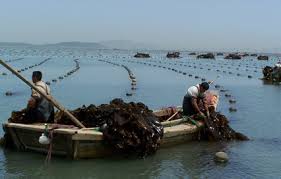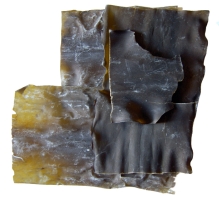- Goiter and scrofula, with
Sargassum
siliquastrum- Hai zao.
[6]
[1] Barefoot Doctor's Manual- 1977 Prepared by the Revolutionary Health Committee
of Hunan Province. Original Chinese manual- Victor W. Sidel. Originally published
by Dr Joseph Quin and the Fogarty International centre, Bethdesda (1974). Madrona
Publishers Seattle Washington ISBN 0-914842-52-8
[2] A Complete English Dictionary of Medicinal Terms in Chinese Acupuncture
and Herbalism 1981- Henry Lu Chinese Foundations of Natural Health- The Academy
of Oriental Heritage, Vancouver, Canada.
[3] Chinese System of Food Cures Prevention and Remedies. 1986 Lu, Henry. Sterling
Publishing Co., Inc. New York. USA. Distributed in Australia by Capricorn Book
Co. Pty Ltd. Lane Cove, NSW. ISBN 0-8069-6308-5.
[4] Medicated Diet of Traditional Chinese Medicine - Chief Editor- Hou Jinglun.
Associate Editors- Zhao Xin, Li Weidong, Liu Jianxin, Geng Chun-e, Li Guohua,
Li Shaohua. Geijing. Science & Technology Press 1994. ISBN 7-5304-1735-5/R.
309.
[5] Yang Yifang, Chinese Herbal Medicines: Comparisons and Characteristics,
2002 Churchill-Livingstone, London.
[6] Chinese Herbal Medicine Materia Medica- Dan Bensky and Andrew Gamble- Eastland
Press 1986 Seattle Washington ISBN 0-939616-15-7
[7]
Chinese Medicinal Herbs- Beatrice Bliss (1973) Compiled
by Li Shi- Chen. Translated and Researched by F. Porter Smith and G. A. Stuart.
Geogetown Press, San FranciscoISBN 0 914558005
Images
1.
en.wikipedia.org
CC BY-SA 3.0 by Lyzzy
2.
ferrebeekeeper.wordpress.com Saccharina japonica, Laminaria
japonica, L.
saccharina, Ecklonia
kurome
昆
布
Kūn bù- "Similar to the Japanese word Konbu",
Kombu,
Ecklonia, Japanese Sea Tangle
Family: Laminariaceae
Saccharina japonica, Laminaria
japonica, L.
saccharina, Ecklonia
kurome
昆
布
Kūn bù- "Similar to the Japanese word Konbu",
Kombu,
Ecklonia, Japanese Sea Tangle
Family: Laminariaceae
